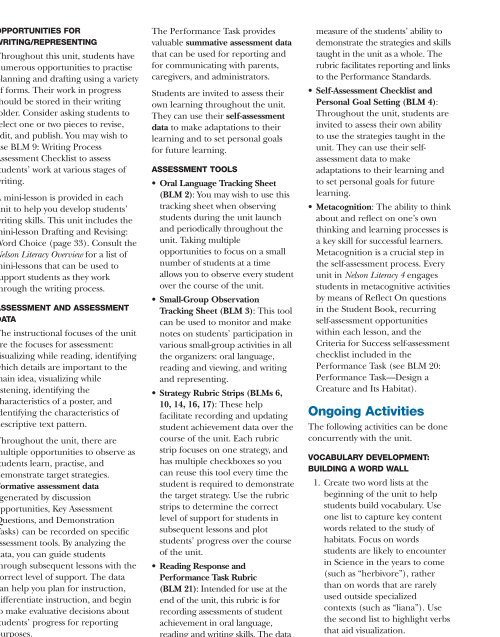Teacher's Resource - Nelson Education
Teacher's Resource - Nelson Education
Teacher's Resource - Nelson Education
Create successful ePaper yourself
Turn your PDF publications into a flip-book with our unique Google optimized e-Paper software.
OPPORTUNITIES FOR<br />
WRITING/REPRESENTING<br />
Throughout this unit, students have<br />
numerous opportunities to practise<br />
planning and drafting using a variety<br />
of forms. Their work in progress<br />
should be stored in their writing<br />
folder. Consider asking students to<br />
select one or two pieces to revise,<br />
edit, and publish. You may wish to<br />
use BLM 9: Writing Process<br />
Assessment Checklist to assess<br />
students’ work at various stages of<br />
writing.<br />
A mini-lesson is provided in each<br />
unit to help you develop students’<br />
writing skills. This unit includes the<br />
mini-lesson Drafting and Revising:<br />
Word Choice (page 33). Consult the<br />
<strong>Nelson</strong> Literacy Overview for a list of<br />
mini-lessons that can be used to<br />
support students as they work<br />
through the writing process.<br />
ASSESSMENT AND ASSESSMENT<br />
DATA<br />
The instructional focuses of the unit<br />
are the focuses for assessment:<br />
visualizing while reading, identifying<br />
which details are important to the<br />
main idea, visualizing while<br />
listening, identifying the<br />
characteristics of a poster, and<br />
identifying the characteristics of<br />
descriptive text pattern.<br />
Throughout the unit, there are<br />
multiple opportunities to observe as<br />
students learn, practise, and<br />
demonstrate target strategies.<br />
Formative assessment data<br />
(generated by discussion<br />
opportunities, Key Assessment<br />
Questions, and Demonstration<br />
Tasks) can be recorded on specific<br />
assessment tools. By analyzing the<br />
data, you can guide students<br />
through subsequent lessons with the<br />
correct level of support. The data<br />
can help you plan for instruction,<br />
differentiate instruction, and begin<br />
to make evaluative decisions about<br />
students’ progress for reporting<br />
purposes.<br />
The Performance Task provides<br />
valuable summative assessment data<br />
that can be used for reporting and<br />
for communicating with parents,<br />
caregivers, and administrators.<br />
Students are invited to assess their<br />
own learning throughout the unit.<br />
They can use their self-assessment<br />
data to make adaptations to their<br />
learning and to set personal goals<br />
for future learning.<br />
ASSESSMENT TOOLS<br />
• Oral Language Tracking Sheet<br />
(BLM 2): You may wish to use this<br />
tracking sheet when observing<br />
students during the unit launch<br />
and periodically throughout the<br />
unit. Taking multiple<br />
opportunities to focus on a small<br />
number of students at a time<br />
allows you to observe every student<br />
over the course of the unit.<br />
• Small-Group Observation<br />
Tracking Sheet (BLM 3): This tool<br />
can be used to monitor and make<br />
notes on students’ participation in<br />
various small-group activities in all<br />
the organizers: oral language,<br />
reading and viewing, and writing<br />
and representing.<br />
• Strategy Rubric Strips (BLMs 6,<br />
10, 14, 16, 17): These help<br />
facilitate recording and updating<br />
student achievement data over the<br />
course of the unit. Each rubric<br />
strip focuses on one strategy, and<br />
has multiple checkboxes so you<br />
can reuse this tool every time the<br />
student is required to demonstrate<br />
the target strategy. Use the rubric<br />
strips to determine the correct<br />
level of support for students in<br />
subsequent lessons and plot<br />
students’ progress over the course<br />
of the unit.<br />
• Reading Response and<br />
Performance Task Rubric<br />
(BLM 21): Intended for use at the<br />
end of the unit, this rubric is for<br />
recording assessments of student<br />
achievement in oral language,<br />
reading and writing skills. The data<br />
can be used as a summative<br />
measure of the students’ ability to<br />
demonstrate the strategies and skills<br />
taught in the unit as a whole. The<br />
rubric facilitates reporting and links<br />
to the Performance Standards.<br />
• Self-Assessment Checklist and<br />
Personal Goal Setting (BLM 4):<br />
Throughout the unit, students are<br />
invited to assess their own ability<br />
to use the strategies taught in the<br />
unit. They can use their selfassessment<br />
data to make<br />
adaptations to their learning and<br />
to set personal goals for future<br />
learning.<br />
• Metacognition: The ability to think<br />
about and reflect on one’s own<br />
thinking and learning processes is<br />
a key skill for successful learners.<br />
Metacognition is a crucial step in<br />
the self-assessment process. Every<br />
unit in <strong>Nelson</strong> Literacy 4 engages<br />
students in metacognitive activities<br />
by means of Reflect On questions<br />
in the Student Book, recurring<br />
self-assessment opportunities<br />
within each lesson, and the<br />
Criteria for Success self-assessment<br />
checklist included in the<br />
Performance Task (see BLM 20:<br />
Performance Task—Design a<br />
Creature and Its Habitat).<br />
Ongoing Activities<br />
The following activities can be done<br />
concurrently with the unit.<br />
VOCABULARY DEVELOPMENT:<br />
BUILDING A WORD WALL<br />
1. Create two word lists at the<br />
beginning of the unit to help<br />
students build vocabulary. Use<br />
one list to capture key content<br />
words related to the study of<br />
habitats. Focus on words<br />
students are likely to encounter<br />
in Science in the years to come<br />
(such as “herbivore”), rather<br />
than on words that are rarely<br />
used outside specialized<br />
contexts (such as “liana”). Use<br />
the second list to highlight verbs<br />
that aid visualization.<br />
10 <strong>Nelson</strong> Literacy 4 Teacher’s <strong>Resource</strong>: Habitats and Communities<br />
NEL

















